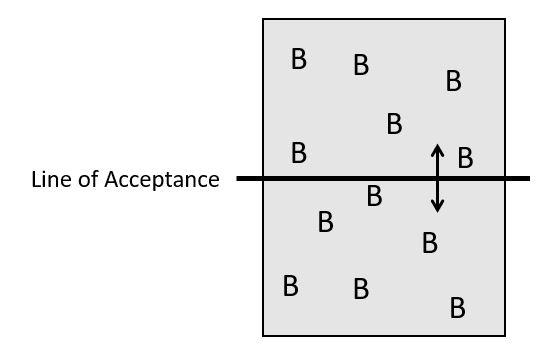In your life and work, you have many relationships; each relationship and each person with whom you interact is unique and different. Yet, when you experience the behavior of any other person, your reaction or response nearly always takes one of two basic forms—either you find the other’s behavior acceptable to you or you find it unacceptable.
your reaction or response nearly always takes one of two basic forms—either you find the other’s behavior acceptable to you or you find it unacceptable.
A very useful way of thinking about another’s behavior is to understand and utilize Dr. Gordon’s Behavior Window.
Each and every behavior (B) of another person you’ll see through this window.
Behavior is something the other person does or says; it is not your judgment of that behavior. For example, your co-worker passing you in the hall and not speaking to you or smiling at you is a behavior. Labeling her as “unfriendly” is a judgment of that behavior.
You can readily accept many of others’ behaviors; some you cannot. All of the acceptable behaviors, the ones that cause you no problem, go into the top part of the window; the unacceptable behaviors, those that cause you a problem, go in the bottom part.
More Examples:
Behavior: “Terry told a funny joke.”
Judgment: “Terry is funny.”
Behavior: “John helped my customer when I was busy.”
Judgment: “John is a team-player.”
The Behavior Window
The dividing line between acceptance and non-acceptance does not remain stationary. The arrows shown on the Line of Acceptance symbolize these continuous changes in your feelings of acceptance about the behavior of others. Three factors keep these feelings in a constant state of motion—the self, the environment and the other person:
The Self. Your present state of mind, activities, feelings and needs can greatly affect your feelings of acceptance of another’s behavior. Example: Laughter and loud conversation, ordinarily acceptable to you, may be unacceptable while concentrating on a difficult work task.
The Environment. The time and place in which the behavior occurs influences your level of acceptance. As an example, you might be totally accepting of your co-worker’s joke when told in private but not on a group Zoom call.
The Other Person. Your feelings of acceptance also vary from person to person. You are not equally accepting of all people. Your perception of others result from your prior experiences with them and also on your biases about them (e.g.. men, women, under/overweight people, lawyers, minorities, etc.) Consequently, you may feel accepting of the behavior of one person and unaccepting of the same behavior by another.
The ability to recognize and acknowledge when another person’s behavior is acceptable or not is a crucial factor in choosing which course skills to use or even if any are needed.

